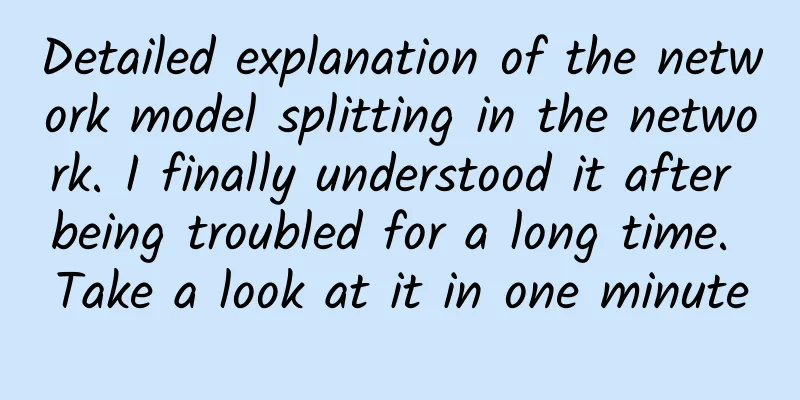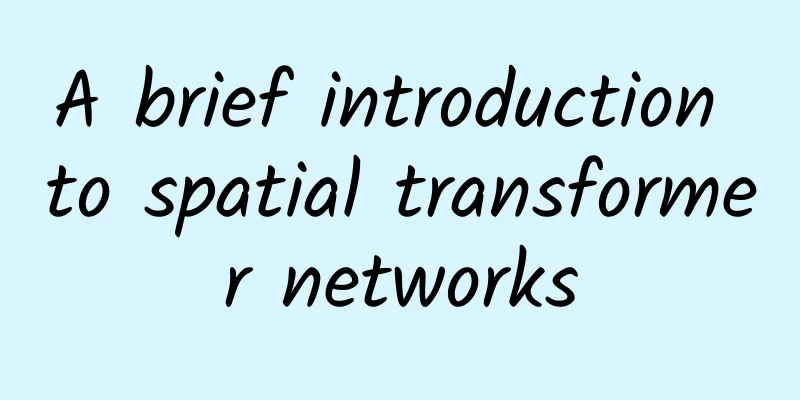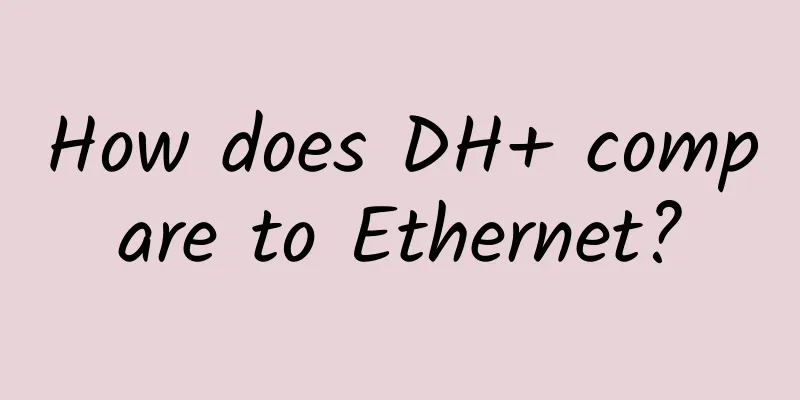Detailed explanation of the network model splitting in the network. I finally understood it after being troubled for a long time. Take a look at it in one minute

|
Seven-layer model decomposition From the application layer to the bottom: 1. Application layer The Application layer, as the interface between the actual application and the presentation layer, delivers the application's relevant information to the lower layers of the protocol stack in some way. It is just an interface for the application and will only work when remote resources need to be processed. The application layer is also responsible for identifying and establishing the availability of the computer that wants to communicate.
2. Presentation layer The presentation layer is named after its purpose. It provides data to the application layer and is responsible for data conversion and code formatting. It mainly provides data compression, encryption and conversion services, such as tiff, jpeg, midi, rtf, etc. 3. Session layer Responsible for establishing, managing and terminating session connections between presentation layer entities, it coordinates the communication process between systems and provides three different ways to organize the communication between them: full duplex, half duplex, and simplex (full duplex, half duplex simplex) communication. In short, the session layer is basically used to keep the data of different applications isolated from the data of other applications. Some examples of Session layer protocols and interfaces:
4. Transport layer Segment and reassemble data into data streams. TCP and UDP both work at the transport layer. When using the TCP/IP protocol, program developers can choose between the two. The transport layer is responsible for implementing multiplexing of upper-layer applications, establishing session connections, and providing mechanisms to disconnect virtual circuits. By providing transparent data transmission, it also hides any network-related details from the upper layer. (1) Flow control: Data integrity can be ensured by performing flow control at the transport layer and by allowing users to request reliable data transmission between systems. Flow control prevents the sending host on one side of the connection from overflowing the receiving host's buffer. Buffer overflow will result in incomplete data. If the data sender transmits data too quickly, the receiver temporarily stores the datagrams in the buffer. Reliable data transmission uses connection-oriented (connection-oriented) communication mode, ensuring:
connection-oriented communication: In reliable transport layer operation, a device that wants to transmit establishes a connection with a remote device by creating a session, commonly known as the 3-way handshake protocol. (2) Handshake protocol: (three-way handshake);
When the amount of data transmitted is too large, some problems may occur. A machine receives a large number of data packets too quickly, causing the buffer to overflow and eventually having to discard all subsequent data packets. But don't worry, there is a flow control system in the network. In this case, the receiver will send a not ready signal, and after processing, it will send a ready, go on signal to continue transmission. Flow control types: window mechanism, buffering and congestion avoidance. a. Windowing The number of data segments that the sender is allowed to send without receiving an acknowledgment is called the window. The size of the window controls how much information is transmitted from one end to the other. Although some protocols quantify information in terms of the number of packets, TCP/IP quantifies information by counting the number of bytes. b. Confirmation In order to ensure that data transmission is not repeated and lost, it can be achieved through "positive confirmation with retransmission". The method is to require the receiver to send a confirmation message to the sender when receiving the data to maintain communication with the sender's machine. When sending a data packet, the sender starts a timer. If no confirmation is received from the other party within the specified time, it will display request time out and resend it. 5. Network layer Responsible for device addressing, tracking the location of devices in the network, and determining the best path to send data. Routers and layer 3 switches work at this layer. How routing works: First, a packet is received, then its destination IP is checked, the routing table is queried, the best path is selected, an interface is selected, and the packet is sent to that port, encapsulated into a frame, and sent out of the local network. If the corresponding destination network entry is not found in the routing table, the packet is automatically discarded. The network layer has two types of packets: data packets and router update packets. The former, obviously, is used to transmit user data. The latter is used to notify adjacent routers of update information of all routers connected to the network. This protocol is an active routing protocol, such as RIP EiGRPOSPF. Routing table:
Contains the following information:
Router features:
6. Data link layer The Data Link layer is responsible for the physical transmission of data, error detection, network topology and flow control. This means that on the data LAN, delivery will be made based on the hardware address, and the Network layer packets will be translated into bits for transmission on the Physical layer. The Data Link layer of IEEE Ethernet has 2 sublayers:
The second layer of devices, switches, are considered hardware-based bridges because they use a special type of hardware called an application-specific integrated circuit (ASIC). ASICs can reach gigabit speeds with very low latency; bridges are software-based. Delay: The time it takes for a frame to reach the outgoing port from the incoming port. Transparent bridging: If the target device and the frame are in the same network segment, the layer 2 device will block the port to prevent the frame from being transmitted to other network segments; if the target device is in a different network segment, the frame will only be transmitted to the network segment where the target device is located. Each network segment connected to switches must have the same type of devices. For example, you cannot mix hosts on Token Ring and hosts on Ethernet with switches. This method is called media translation, but you can use routers to connect different types of networks. The advantages of using switches over hubs in a LAN are:
7. Physical layer The Physical layer is responsible for sending and receiving bits, which are composed of 1 or 0. This layer is also used to identify the interface between data terminal equipment (DTE) and data communication equipment (DCE). DCE is usually located in the service provider and DTE is usually an auxiliary device. The available DTE services are usually accessed through a modem or channel service unit/data service unit (CSU/DSU) to hubs: they are actually multi-port repeaters that re-amplify the signal to solve problems such as long lines and signal attenuation. 1 Physical star topology, actually a logical bus topology: |
<<: 12 Questions about Routing! Do you know all of them?
>>: The TRUST principle for 6G network performance experience
Recommend
V5.NET New Year 20% off, Hong Kong E5 dedicated server monthly payment starts from HK$440
V5.NET is a business that provides independent se...
The three major operators were forced to delist from the US: the impact was not significant but the intention was obvious
On December 31 last year, the New York Stock Exch...
A leap from concept to practice! How does the cloud's native "immune system" fight organically?
On July 16, the Alibaba Cloud Native Security Onl...
Wi-Fi signals are invisible and intangible, but there are actually traces to follow
Labs Guide Have you ever encountered the phenomen...
How to solve the air pollution problem in data centers?
One might think that the issue of air purity in d...
Nexril: $9/quarter KVM-1GB/15G SSD/1TB/Dallas data center
Nexril is a site under Corex Solutions, LLC. It w...
Liu Liehong: my country has built the world's largest optical fiber network and 4G network
[[391129]] On March 31, the "2021 Digital Tr...
10 bad habits network administrators should avoid at all costs
Every enterprise network consists of devices that...
5G and the Internet of Things empower the home appliance industry to promote the consumption of green and energy-saving home appliances
The great progress of social productivity has giv...
China Unicom opens two submarine optical cables: 100Gbps connecting Europe, Asia and Africa
Recently, China Unicom officially announced that ...
The three major telecom operators have begun to deploy 5G messaging on a large scale
5G messaging, which is seen by the industry as We...
Network performance metrics pose data center challenges
The networking world is known for widespread chan...
5G technology enables smart transportation, and operators add more ingredients to make the cake bigger
Recently, the Ministry of Transport, together wit...
The key challenges facing MSPs and CMPs in “multi-cloud” are: Network
The rapid development of new cloud-based applicat...









